Static Mixers: Functional Information, Types, and Limitations
VerifiedAdded on 2023/06/14
|8
|1591
|226
AI Summary
This paper provides practical information on static mixers, their types, functionalities, and limitations. It also includes test applications and blender selection tips. The efficiency of static mixers in processes is discussed, along with their beneficial aspects in terms of opex and capex. The paper concludes with limitations and references.
Contribute Materials
Your contribution can guide someone’s learning journey. Share your
documents today.

STATIC MIXERS
Name:
Reg:
Course
1
Name:
Reg:
Course
1
Secure Best Marks with AI Grader
Need help grading? Try our AI Grader for instant feedback on your assignments.
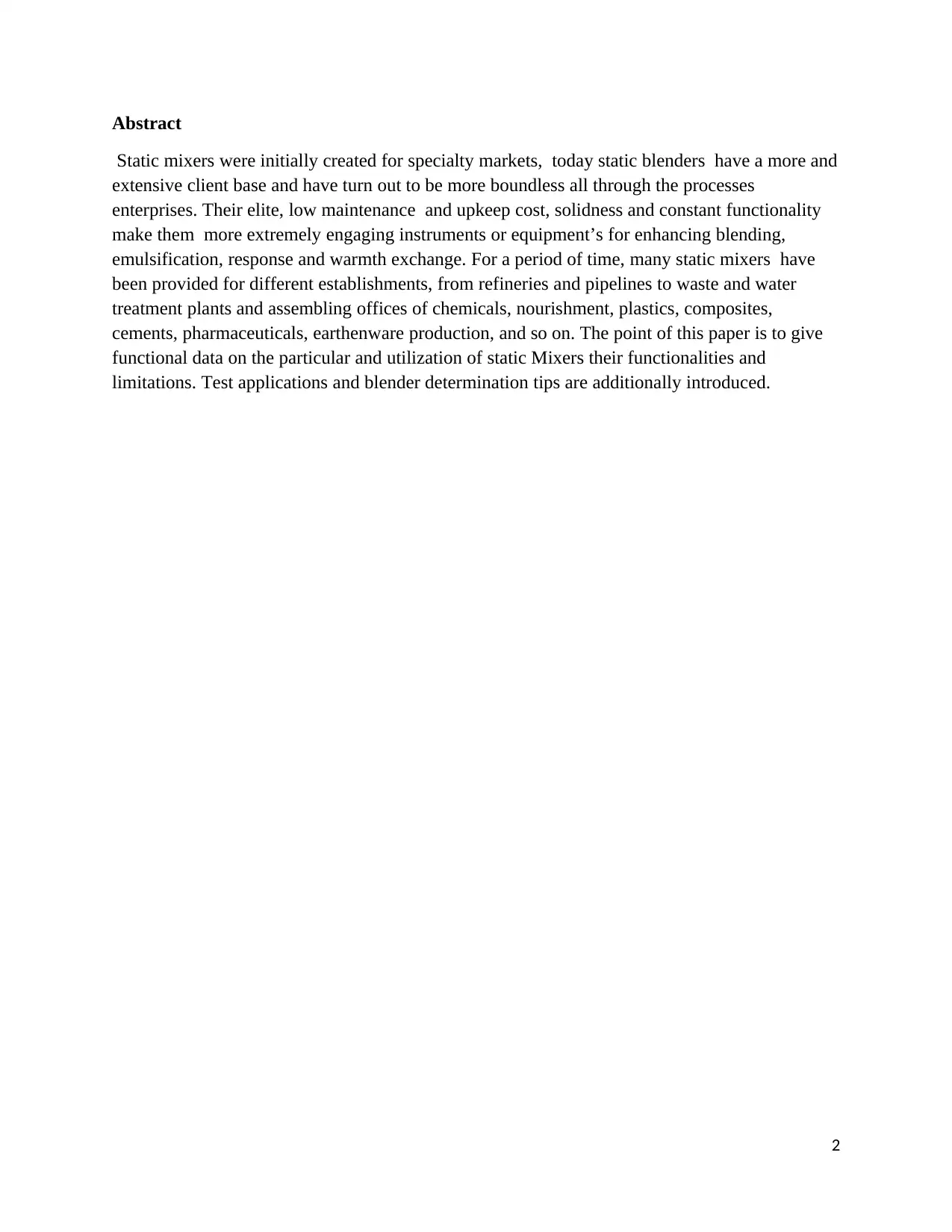
Abstract
Static mixers were initially created for specialty markets, today static blenders have a more and
extensive client base and have turn out to be more boundless all through the processes
enterprises. Their elite, low maintenance and upkeep cost, solidness and constant functionality
make them more extremely engaging instruments or equipment’s for enhancing blending,
emulsification, response and warmth exchange. For a period of time, many static mixers have
been provided for different establishments, from refineries and pipelines to waste and water
treatment plants and assembling offices of chemicals, nourishment, plastics, composites,
cements, pharmaceuticals, earthenware production, and so on. The point of this paper is to give
functional data on the particular and utilization of static Mixers their functionalities and
limitations. Test applications and blender determination tips are additionally introduced.
2
Static mixers were initially created for specialty markets, today static blenders have a more and
extensive client base and have turn out to be more boundless all through the processes
enterprises. Their elite, low maintenance and upkeep cost, solidness and constant functionality
make them more extremely engaging instruments or equipment’s for enhancing blending,
emulsification, response and warmth exchange. For a period of time, many static mixers have
been provided for different establishments, from refineries and pipelines to waste and water
treatment plants and assembling offices of chemicals, nourishment, plastics, composites,
cements, pharmaceuticals, earthenware production, and so on. The point of this paper is to give
functional data on the particular and utilization of static Mixers their functionalities and
limitations. Test applications and blender determination tips are additionally introduced.
2
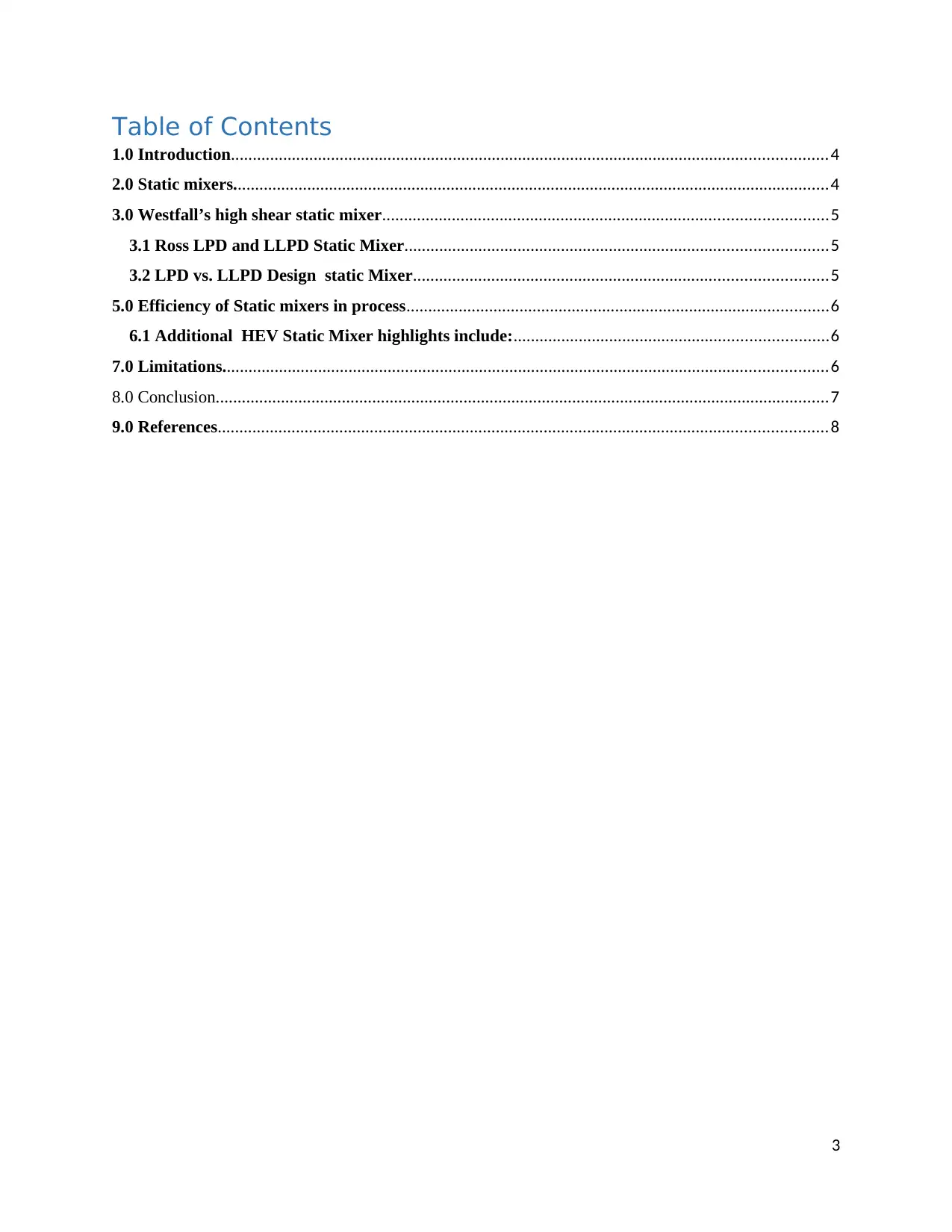
Table of Contents
1.0 Introduction.........................................................................................................................................4
2.0 Static mixers.........................................................................................................................................4
3.0 Westfall’s high shear static mixer......................................................................................................5
3.1 Ross LPD and LLPD Static Mixer.................................................................................................5
3.2 LPD vs. LLPD Design static Mixer...............................................................................................5
5.0 Efficiency of Static mixers in process.................................................................................................6
6.1 Additional HEV Static Mixer highlights include:........................................................................6
7.0 Limitations...........................................................................................................................................6
8.0 Conclusion.............................................................................................................................................7
9.0 References............................................................................................................................................8
3
1.0 Introduction.........................................................................................................................................4
2.0 Static mixers.........................................................................................................................................4
3.0 Westfall’s high shear static mixer......................................................................................................5
3.1 Ross LPD and LLPD Static Mixer.................................................................................................5
3.2 LPD vs. LLPD Design static Mixer...............................................................................................5
5.0 Efficiency of Static mixers in process.................................................................................................6
6.1 Additional HEV Static Mixer highlights include:........................................................................6
7.0 Limitations...........................................................................................................................................6
8.0 Conclusion.............................................................................................................................................7
9.0 References............................................................................................................................................8
3
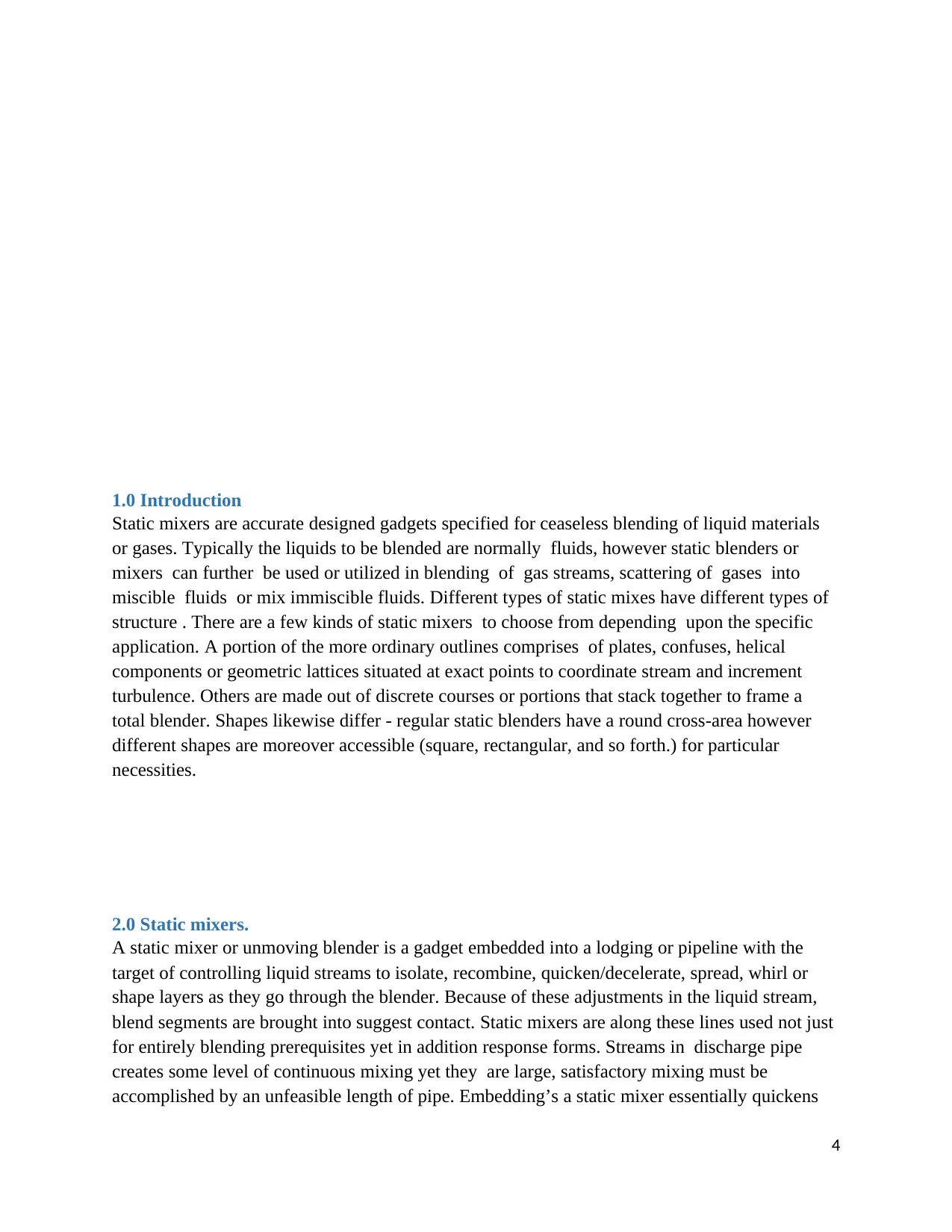
1.0 Introduction
Static mixers are accurate designed gadgets specified for ceaseless blending of liquid materials
or gases. Typically the liquids to be blended are normally fluids, however static blenders or
mixers can further be used or utilized in blending of gas streams, scattering of gases into
miscible fluids or mix immiscible fluids. Different types of static mixes have different types of
structure . There are a few kinds of static mixers to choose from depending upon the specific
application. A portion of the more ordinary outlines comprises of plates, confuses, helical
components or geometric lattices situated at exact points to coordinate stream and increment
turbulence. Others are made out of discrete courses or portions that stack together to frame a
total blender. Shapes likewise differ - regular static blenders have a round cross-area however
different shapes are moreover accessible (square, rectangular, and so forth.) for particular
necessities.
2.0 Static mixers.
A static mixer or unmoving blender is a gadget embedded into a lodging or pipeline with the
target of controlling liquid streams to isolate, recombine, quicken/decelerate, spread, whirl or
shape layers as they go through the blender. Because of these adjustments in the liquid stream,
blend segments are brought into suggest contact. Static mixers are along these lines used not just
for entirely blending prerequisites yet in addition response forms. Streams in discharge pipe
creates some level of continuous mixing yet they are large, satisfactory mixing must be
accomplished by an unfeasible length of pipe. Embedding’s a static mixer essentially quickens
4
Static mixers are accurate designed gadgets specified for ceaseless blending of liquid materials
or gases. Typically the liquids to be blended are normally fluids, however static blenders or
mixers can further be used or utilized in blending of gas streams, scattering of gases into
miscible fluids or mix immiscible fluids. Different types of static mixes have different types of
structure . There are a few kinds of static mixers to choose from depending upon the specific
application. A portion of the more ordinary outlines comprises of plates, confuses, helical
components or geometric lattices situated at exact points to coordinate stream and increment
turbulence. Others are made out of discrete courses or portions that stack together to frame a
total blender. Shapes likewise differ - regular static blenders have a round cross-area however
different shapes are moreover accessible (square, rectangular, and so forth.) for particular
necessities.
2.0 Static mixers.
A static mixer or unmoving blender is a gadget embedded into a lodging or pipeline with the
target of controlling liquid streams to isolate, recombine, quicken/decelerate, spread, whirl or
shape layers as they go through the blender. Because of these adjustments in the liquid stream,
blend segments are brought into suggest contact. Static mixers are along these lines used not just
for entirely blending prerequisites yet in addition response forms. Streams in discharge pipe
creates some level of continuous mixing yet they are large, satisfactory mixing must be
accomplished by an unfeasible length of pipe. Embedding’s a static mixer essentially quickens
4
Secure Best Marks with AI Grader
Need help grading? Try our AI Grader for instant feedback on your assignments.
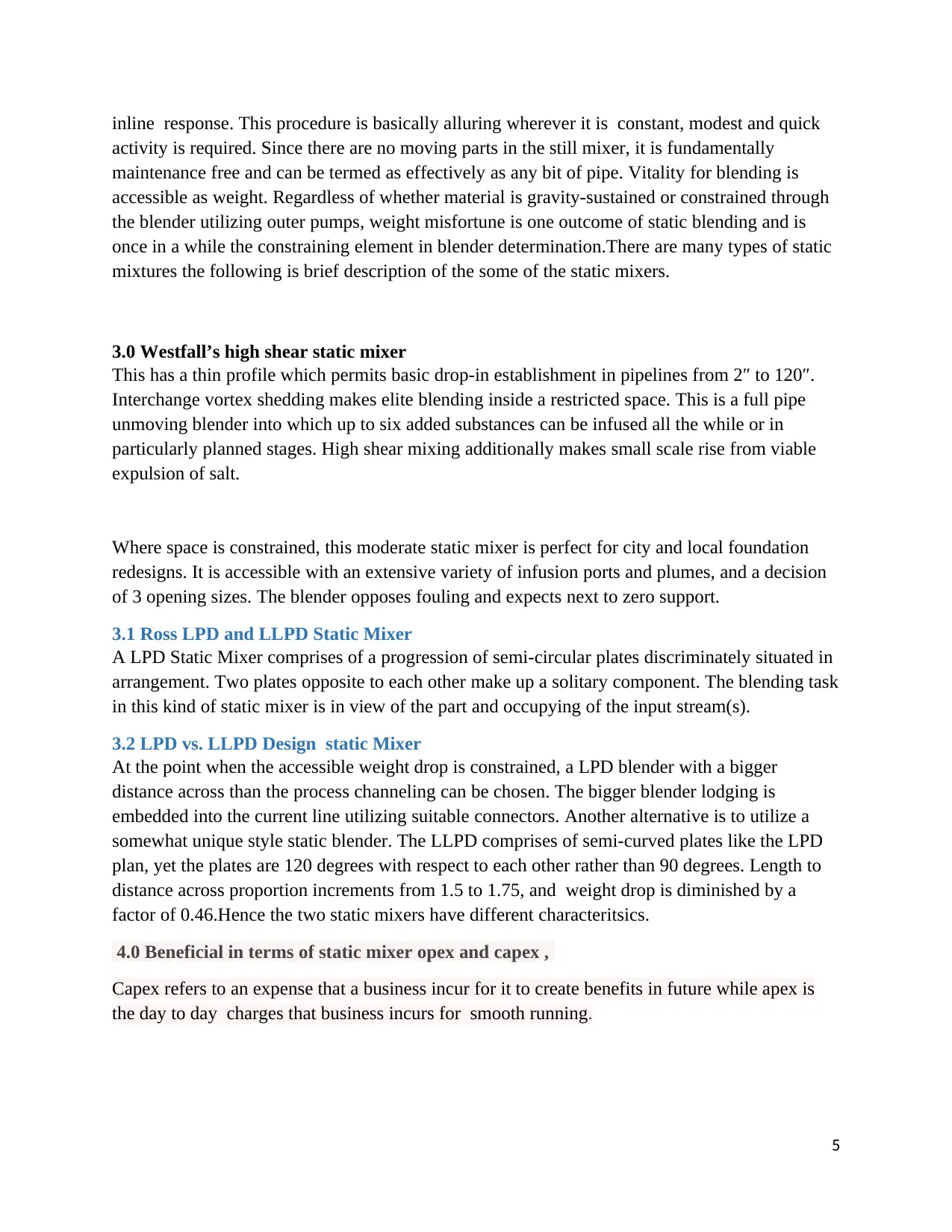
inline response. This procedure is basically alluring wherever it is constant, modest and quick
activity is required. Since there are no moving parts in the still mixer, it is fundamentally
maintenance free and can be termed as effectively as any bit of pipe. Vitality for blending is
accessible as weight. Regardless of whether material is gravity-sustained or constrained through
the blender utilizing outer pumps, weight misfortune is one outcome of static blending and is
once in a while the constraining element in blender determination.There are many types of static
mixtures the following is brief description of the some of the static mixers.
3.0 Westfall’s high shear static mixer
This has a thin profile which permits basic drop-in establishment in pipelines from 2″ to 120″.
Interchange vortex shedding makes elite blending inside a restricted space. This is a full pipe
unmoving blender into which up to six added substances can be infused all the while or in
particularly planned stages. High shear mixing additionally makes small scale rise from viable
expulsion of salt.
Where space is constrained, this moderate static mixer is perfect for city and local foundation
redesigns. It is accessible with an extensive variety of infusion ports and plumes, and a decision
of 3 opening sizes. The blender opposes fouling and expects next to zero support.
3.1 Ross LPD and LLPD Static Mixer
A LPD Static Mixer comprises of a progression of semi-circular plates discriminately situated in
arrangement. Two plates opposite to each other make up a solitary component. The blending task
in this kind of static mixer is in view of the part and occupying of the input stream(s).
3.2 LPD vs. LLPD Design static Mixer
At the point when the accessible weight drop is constrained, a LPD blender with a bigger
distance across than the process channeling can be chosen. The bigger blender lodging is
embedded into the current line utilizing suitable connectors. Another alternative is to utilize a
somewhat unique style static blender. The LLPD comprises of semi-curved plates like the LPD
plan, yet the plates are 120 degrees with respect to each other rather than 90 degrees. Length to
distance across proportion increments from 1.5 to 1.75, and weight drop is diminished by a
factor of 0.46.Hence the two static mixers have different characteritsics.
4.0 Beneficial in terms of static mixer opex and capex ,
Capex refers to an expense that a business incur for it to create benefits in future while apex is
the day to day charges that business incurs for smooth running.
5
activity is required. Since there are no moving parts in the still mixer, it is fundamentally
maintenance free and can be termed as effectively as any bit of pipe. Vitality for blending is
accessible as weight. Regardless of whether material is gravity-sustained or constrained through
the blender utilizing outer pumps, weight misfortune is one outcome of static blending and is
once in a while the constraining element in blender determination.There are many types of static
mixtures the following is brief description of the some of the static mixers.
3.0 Westfall’s high shear static mixer
This has a thin profile which permits basic drop-in establishment in pipelines from 2″ to 120″.
Interchange vortex shedding makes elite blending inside a restricted space. This is a full pipe
unmoving blender into which up to six added substances can be infused all the while or in
particularly planned stages. High shear mixing additionally makes small scale rise from viable
expulsion of salt.
Where space is constrained, this moderate static mixer is perfect for city and local foundation
redesigns. It is accessible with an extensive variety of infusion ports and plumes, and a decision
of 3 opening sizes. The blender opposes fouling and expects next to zero support.
3.1 Ross LPD and LLPD Static Mixer
A LPD Static Mixer comprises of a progression of semi-circular plates discriminately situated in
arrangement. Two plates opposite to each other make up a solitary component. The blending task
in this kind of static mixer is in view of the part and occupying of the input stream(s).
3.2 LPD vs. LLPD Design static Mixer
At the point when the accessible weight drop is constrained, a LPD blender with a bigger
distance across than the process channeling can be chosen. The bigger blender lodging is
embedded into the current line utilizing suitable connectors. Another alternative is to utilize a
somewhat unique style static blender. The LLPD comprises of semi-curved plates like the LPD
plan, yet the plates are 120 degrees with respect to each other rather than 90 degrees. Length to
distance across proportion increments from 1.5 to 1.75, and weight drop is diminished by a
factor of 0.46.Hence the two static mixers have different characteritsics.
4.0 Beneficial in terms of static mixer opex and capex ,
Capex refers to an expense that a business incur for it to create benefits in future while apex is
the day to day charges that business incurs for smooth running.
5
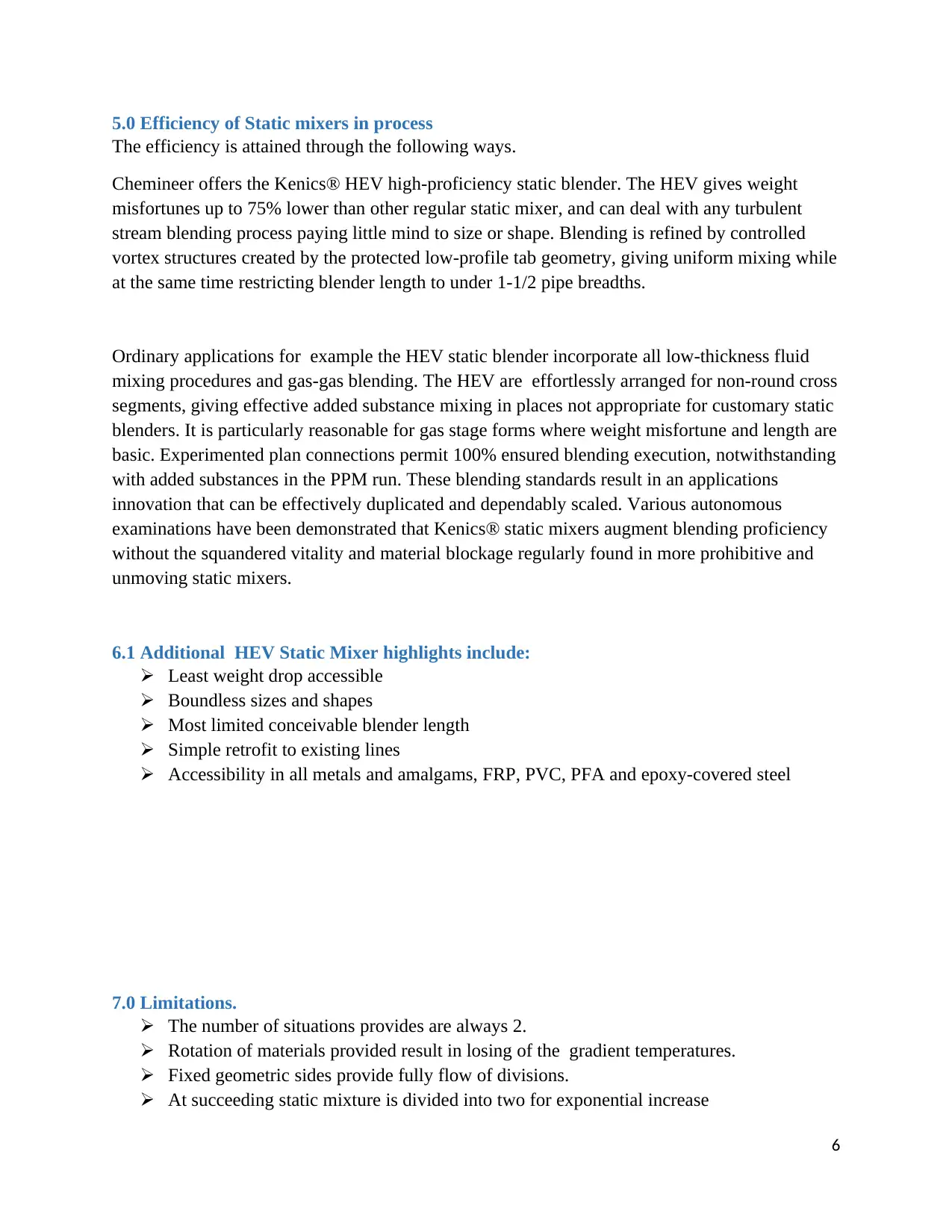
5.0 Efficiency of Static mixers in process
The efficiency is attained through the following ways.
Chemineer offers the Kenics® HEV high-proficiency static blender. The HEV gives weight
misfortunes up to 75% lower than other regular static mixer, and can deal with any turbulent
stream blending process paying little mind to size or shape. Blending is refined by controlled
vortex structures created by the protected low-profile tab geometry, giving uniform mixing while
at the same time restricting blender length to under 1-1/2 pipe breadths.
Ordinary applications for example the HEV static blender incorporate all low-thickness fluid
mixing procedures and gas-gas blending. The HEV are effortlessly arranged for non-round cross
segments, giving effective added substance mixing in places not appropriate for customary static
blenders. It is particularly reasonable for gas stage forms where weight misfortune and length are
basic. Experimented plan connections permit 100% ensured blending execution, notwithstanding
with added substances in the PPM run. These blending standards result in an applications
innovation that can be effectively duplicated and dependably scaled. Various autonomous
examinations have been demonstrated that Kenics® static mixers augment blending proficiency
without the squandered vitality and material blockage regularly found in more prohibitive and
unmoving static mixers.
6.1 Additional HEV Static Mixer highlights include:
Least weight drop accessible
Boundless sizes and shapes
Most limited conceivable blender length
Simple retrofit to existing lines
Accessibility in all metals and amalgams, FRP, PVC, PFA and epoxy-covered steel
7.0 Limitations.
The number of situations provides are always 2.
Rotation of materials provided result in losing of the gradient temperatures.
Fixed geometric sides provide fully flow of divisions.
At succeeding static mixture is divided into two for exponential increase
6
The efficiency is attained through the following ways.
Chemineer offers the Kenics® HEV high-proficiency static blender. The HEV gives weight
misfortunes up to 75% lower than other regular static mixer, and can deal with any turbulent
stream blending process paying little mind to size or shape. Blending is refined by controlled
vortex structures created by the protected low-profile tab geometry, giving uniform mixing while
at the same time restricting blender length to under 1-1/2 pipe breadths.
Ordinary applications for example the HEV static blender incorporate all low-thickness fluid
mixing procedures and gas-gas blending. The HEV are effortlessly arranged for non-round cross
segments, giving effective added substance mixing in places not appropriate for customary static
blenders. It is particularly reasonable for gas stage forms where weight misfortune and length are
basic. Experimented plan connections permit 100% ensured blending execution, notwithstanding
with added substances in the PPM run. These blending standards result in an applications
innovation that can be effectively duplicated and dependably scaled. Various autonomous
examinations have been demonstrated that Kenics® static mixers augment blending proficiency
without the squandered vitality and material blockage regularly found in more prohibitive and
unmoving static mixers.
6.1 Additional HEV Static Mixer highlights include:
Least weight drop accessible
Boundless sizes and shapes
Most limited conceivable blender length
Simple retrofit to existing lines
Accessibility in all metals and amalgams, FRP, PVC, PFA and epoxy-covered steel
7.0 Limitations.
The number of situations provides are always 2.
Rotation of materials provided result in losing of the gradient temperatures.
Fixed geometric sides provide fully flow of divisions.
At succeeding static mixture is divided into two for exponential increase
6

8.0 Conclusion.
The part of static mixers in present day assembling and manufacturing industries continue to be
a critical one. Despite the fact that they are moderately reasonable apparatus, legitimate plan and
determination of static mixers must not be underestimated to guarantee ideal execution, high
operational proficiency and long haul valuable life. Joining forces with the providers with
broaden experience and a decent reputation of assembling will lead into a dependable and well-
made geared plans.
7
The part of static mixers in present day assembling and manufacturing industries continue to be
a critical one. Despite the fact that they are moderately reasonable apparatus, legitimate plan and
determination of static mixers must not be underestimated to guarantee ideal execution, high
operational proficiency and long haul valuable life. Joining forces with the providers with
broaden experience and a decent reputation of assembling will lead into a dependable and well-
made geared plans.
7
Paraphrase This Document
Need a fresh take? Get an instant paraphrase of this document with our AI Paraphraser
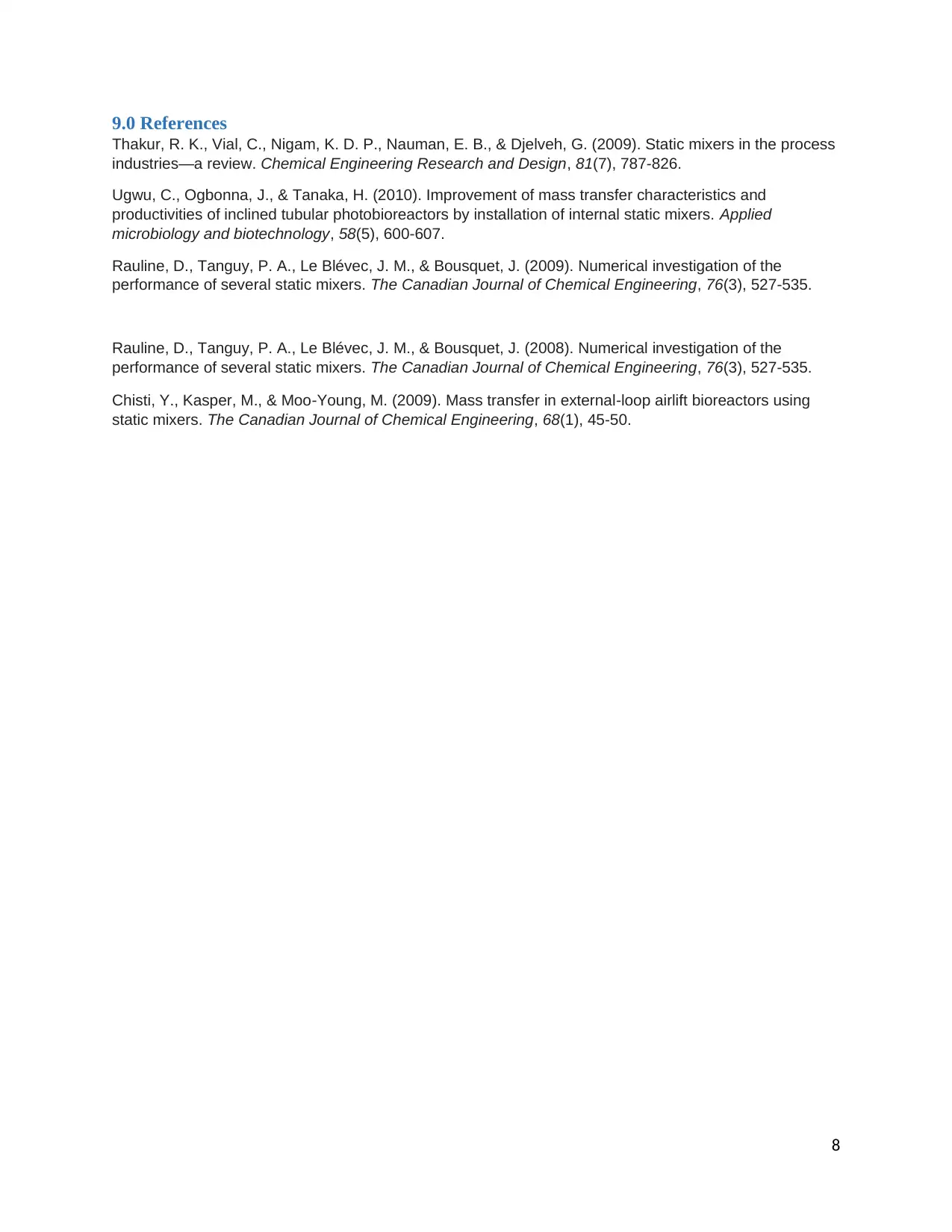
9.0 References
Thakur, R. K., Vial, C., Nigam, K. D. P., Nauman, E. B., & Djelveh, G. (2009). Static mixers in the process
industries—a review. Chemical Engineering Research and Design, 81(7), 787-826.
Ugwu, C., Ogbonna, J., & Tanaka, H. (2010). Improvement of mass transfer characteristics and
productivities of inclined tubular photobioreactors by installation of internal static mixers. Applied
microbiology and biotechnology, 58(5), 600-607.
Rauline, D., Tanguy, P. A., Le Blévec, J. M., & Bousquet, J. (2009). Numerical investigation of the
performance of several static mixers. The Canadian Journal of Chemical Engineering, 76(3), 527-535.
Rauline, D., Tanguy, P. A., Le Blévec, J. M., & Bousquet, J. (2008). Numerical investigation of the
performance of several static mixers. The Canadian Journal of Chemical Engineering, 76(3), 527-535.
Chisti, Y., Kasper, M., & Moo‐Young, M. (2009). Mass transfer in external‐loop airlift bioreactors using
static mixers. The Canadian Journal of Chemical Engineering, 68(1), 45-50.
8
Thakur, R. K., Vial, C., Nigam, K. D. P., Nauman, E. B., & Djelveh, G. (2009). Static mixers in the process
industries—a review. Chemical Engineering Research and Design, 81(7), 787-826.
Ugwu, C., Ogbonna, J., & Tanaka, H. (2010). Improvement of mass transfer characteristics and
productivities of inclined tubular photobioreactors by installation of internal static mixers. Applied
microbiology and biotechnology, 58(5), 600-607.
Rauline, D., Tanguy, P. A., Le Blévec, J. M., & Bousquet, J. (2009). Numerical investigation of the
performance of several static mixers. The Canadian Journal of Chemical Engineering, 76(3), 527-535.
Rauline, D., Tanguy, P. A., Le Blévec, J. M., & Bousquet, J. (2008). Numerical investigation of the
performance of several static mixers. The Canadian Journal of Chemical Engineering, 76(3), 527-535.
Chisti, Y., Kasper, M., & Moo‐Young, M. (2009). Mass transfer in external‐loop airlift bioreactors using
static mixers. The Canadian Journal of Chemical Engineering, 68(1), 45-50.
8
1 out of 8
Your All-in-One AI-Powered Toolkit for Academic Success.
+13062052269
info@desklib.com
Available 24*7 on WhatsApp / Email
![[object Object]](/_next/static/media/star-bottom.7253800d.svg)
Unlock your academic potential
© 2024 | Zucol Services PVT LTD | All rights reserved.